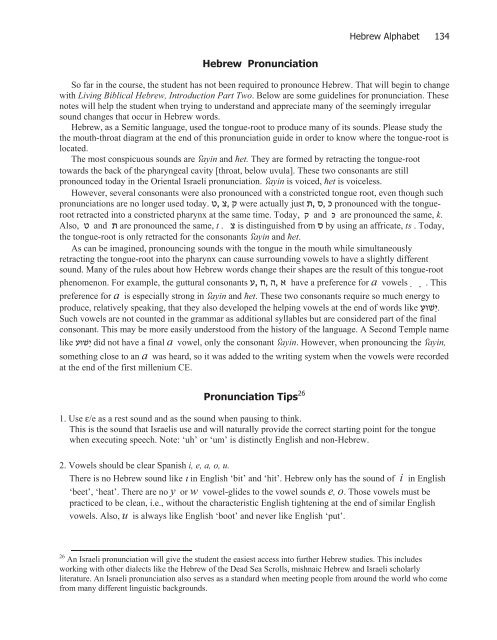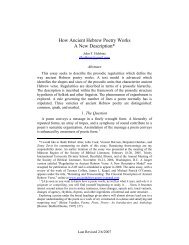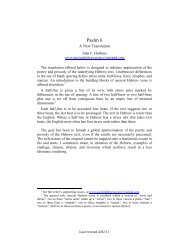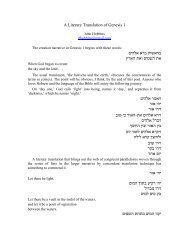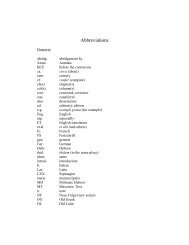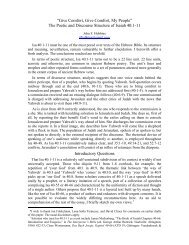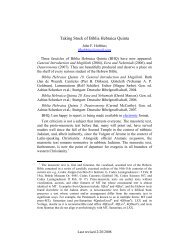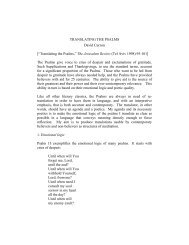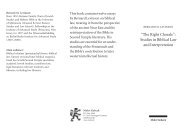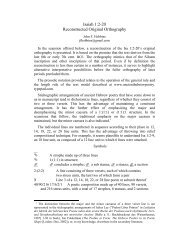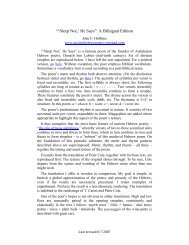Living Biblical Hebrew - Ancient Hebrew Poetry
Living Biblical Hebrew - Ancient Hebrew Poetry
Living Biblical Hebrew - Ancient Hebrew Poetry
Create successful ePaper yourself
Turn your PDF publications into a flip-book with our unique Google optimized e-Paper software.
<strong>Hebrew</strong> Alphabet 134<strong>Hebrew</strong> PronunciationSo far in the course, the student has not been required to pronounce <strong>Hebrew</strong>. That will begin to changewith <strong>Living</strong> <strong>Biblical</strong> <strong>Hebrew</strong>, Introduction Part Two. Below are some guidelines for pronunciation. Thesenotes will help the student when trying to understand and appreciate many of the seemingly irregularsound changes that occur in <strong>Hebrew</strong> words.<strong>Hebrew</strong>, as a Semitic language, used the tongue-root to produce many of its sounds. Please study thethe mouth-throat diagram at the end of this pronunciation guide in order to know where the tongue-root islocated.The most conspicuous sounds are ayin and et. They are formed by retracting the tongue-roottowards the back of the pharyngeal cavity [throat, below uvula]. These two consonants are stillpronounced today in the Oriental Israeli pronunciation. ayin is voiced, et is voiceless.However, several consonants were also pronounced with a constricted tongue root, even though suchpronunciations are no longer used today. , , were actually just , , pronounced with the tonguerootretracted into a constricted pharynx at the same time. Today, and are pronounced the same, k.Also, and are pronounced the same, t . is distinguished from by using an affricate, ts . Today,the tongue-root is only retracted for the consonants ayin and et.As can be imagined, pronouncing sounds with the tongue in the mouth while simultaneouslyretracting the tongue-root into the pharynx can cause surrounding vowels to have a slightly differentsound. Many of the rules about how <strong>Hebrew</strong> words change their shapes are the result of this tongue-rootphenomenon. For example, the guttural consonants , , , have a preference for a vowels . Thispreference for a is especially strong in ayin and et. These two consonants require so much energy toproduce, relatively speaking, that they also developed the helping vowels at the end of words like .Such vowels are not counted in the grammar as additional syllables but are considered part of the finalconsonant. This may be more easily understood from the history of the language. A Second Temple namelike did not have a final a vowel, only the consonant ayin. However, when pronouncing the ayin,something close to an a was heard, so it was added to the writing system when the vowels were recordedat the end of the first millenium CE.Pronunciation Tips 261. Use ε/e as a rest sound and as the sound when pausing to think.This is the sound that Israelis use and will naturally provide the correct starting point for the tonguewhen executing speech. Note: ‘uh’ or ‘um’ is distinctly English and non-<strong>Hebrew</strong>.2. Vowels should be clear Spanish i, e, a, o, u.There is no <strong>Hebrew</strong> sound like ι in English ‘bit’ and ‘hit’. <strong>Hebrew</strong> only has the sound of i in English‘beet’, ‘heat’. There are no y or w vowel-glides to the vowel sounds e, o. Those vowels must bepracticed to be clean, i.e., without the characteristic English tightening at the end of similar Englishvowels. Also, u is always like English ‘boot’ and never like English ‘put’.26 An Israeli pronunciation will give the student the easiest access into further <strong>Hebrew</strong> studies. This includesworking with other dialects like the <strong>Hebrew</strong> of the Dead Sea Scrolls, mishnaic <strong>Hebrew</strong> and Israeli scholarlyliterature. An Israeli pronunciation also serves as a standard when meeting people from around the world who comefrom many different linguistic backgrounds.


